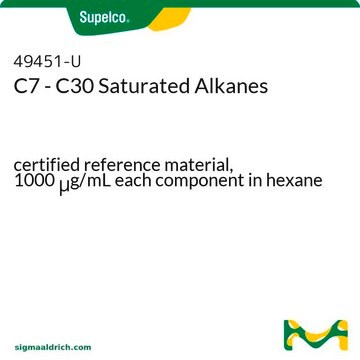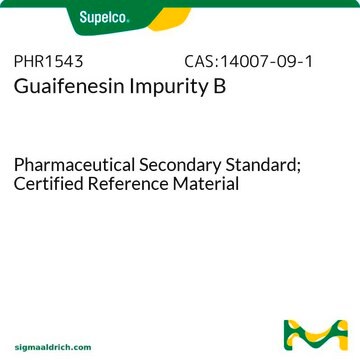Kluczowe dokumenty
Y0000619
Guaiacol
European Pharmacopoeia (EP) Reference Standard
Synonim(y):
2-Methoxyphenol, Catechol monomethyl ether, Pyrocatechol monomethyl ether
About This Item
Polecane produkty
klasa czystości
pharmaceutical primary standard
agency
EP Reference Standard
gęstość pary
4.27 (vs air)
ciśnienie pary
0.11 mmHg ( 25 °C)
rodzina API
guaiacol
producent / nazwa handlowa
EDQM
współczynnik refrakcji
n20/D 1.543 (lit.)
bp
205 °C (lit.)
mp
26-29 °C (lit.)
gęstość
1.129 g/mL at 25 °C (lit.)
Zastosowanie
pharmaceutical (small molecule)
Format
neat
temp. przechowywania
2-8°C
ciąg SMILES
COc1ccccc1O
InChI
1S/C7H8O2/c1-9-7-5-3-2-4-6(7)8/h2-5,8H,1H3
Klucz InChI
LHGVFZTZFXWLCP-UHFFFAOYSA-N
Szukasz podobnych produktów? Odwiedź Przewodnik dotyczący porównywania produktów
Opis ogólny
Zastosowanie
Działania biochem./fizjol.
Opakowanie
Inne uwagi
produkt powiązany
Hasło ostrzegawcze
Warning
Zwroty wskazujące rodzaj zagrożenia
Zwroty wskazujące środki ostrożności
Klasyfikacja zagrożeń
Acute Tox. 4 Oral - Eye Irrit. 2 - Skin Irrit. 2
Kod klasy składowania
11 - Combustible Solids
Klasa zagrożenia wodnego (WGK)
WGK 1
Temperatura zapłonu (°F)
179.6 °F - closed cup
Temperatura zapłonu (°C)
82 °C - closed cup
Wybierz jedną z najnowszych wersji:
Certyfikaty analizy (CoA)
It looks like we've run into a problem, but you can still download Certificates of Analysis from our Dokumenty section.
Proszę o kontakt, jeśli potrzebna jest pomoc Obsługa Klienta
Masz już ten produkt?
Dokumenty związane z niedawno zakupionymi produktami zostały zamieszczone w Bibliotece dokumentów.
Nasz zespół naukowców ma doświadczenie we wszystkich obszarach badań, w tym w naukach przyrodniczych, materiałoznawstwie, syntezie chemicznej, chromatografii, analityce i wielu innych dziedzinach.
Skontaktuj się z zespołem ds. pomocy technicznej





